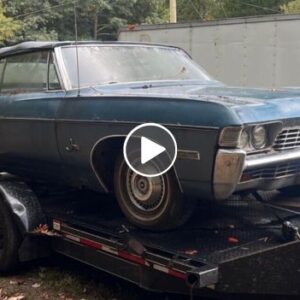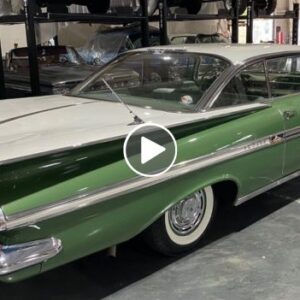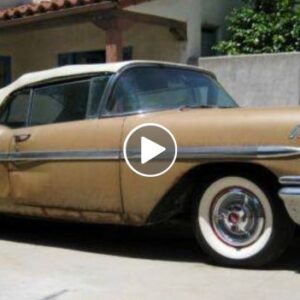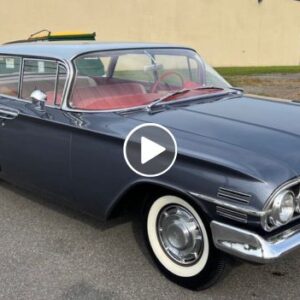Anglia Car Auctions recently gutted a humble Scottish barn loaded with classic cars. Sitting front and center, the Chevrolet Corvette C1 is quite a find. The spoils keep coming, with a Jaguar XK140, followed by a Jaguar E-Type Roadster, a Bentley Mark VI, an MG MGA Roadster, an Austin-Healey Sprite Frogeye, and a Land Rover Series I stranded in a nearby grove. The Anglia Car Auctions team extracts these old barn finds, revealing the classic car enthusiast’s dream come true.
These post-WWII cars embody the history and craft skills of the mid-1900s. Better yet, they’re highly valuable in today’s classic car market. Anglia Car Auctions documents the process from the initial discovery to the car transporter, bringing viewers along for the ride.
The Chevrolet Corvette C1 Is A Performance Classic That Breaks 150 MPH
Engine Specs
| Manufacturer | General Motors |
| Production Years | 1958-1961 |
| Configuration | V8 |
| Displacement | 4.6-liter |
| Power | 230-315 HP |
| Torque | 300 lb-ft |
| Fuel | 16.9 MPG |
| Noteworthy Applications | Chevrolet Corvette C1, Chevrolet Bel Air, Chevrolet Impala |
(specs provided by corvettemuseum.org)
After clearing the barn’s entrance, Anglia Car Auctions’ host Guy Snelling navigates through the crumbling structure. First in the line of post-WWII antiques is a red and white 1959 C1 Chevrolet Corvette that wears layers of its age. The two-tone 1959 C1 is a sports car with performance and elegance, fulfilling Chevrolet’s urge to rival European cars.
The iconic American car experienced significant growth over the course of its production, beginning in the late 1953 model year through 1962. While maintaining its low-slung roadster design with an all-fiberglass body, the C1 adopted GM’s newly introduced 4.3-liter small-block V8 in 1955, which pumped out 195 HP with an optional four-barrel carburetor.
It replaced the 3.85-liter “Blue Flame,” which posted an underwhelming 150 HP. The Corvette’s Chief Engineer Zora Arkus-Duntov, who earned a nickname as the “father of the Corvette,” turned the C1 into a racer with a 4.6-liter engine, a high-lift camshaft, and an optional fuel-injection system.
With these advances, the C1 breached the 150 mph mark and could compete with Jaguar XKs, Austin-Healey’s 100/6, the MG MGA, and of course, the Ford Thunderbird. The C1 marked the beginning of an esteemed legacy in car culture.
According to Chevrolet, the 1959 Corvette’s four-headlight design, distinct grille, fiberglass body, and Rochester Ramjet’s mechanical fuel-injection system caught the Corvette up to Ford’s sports car standard and exceeded it. On Classic.com, the average price for a restored C1 is $127,145. Having this top-of-the-line Chevrolet in the garage is a dream for many enthusiasts.
Pricing
| Trim | Average Used Market Price | Original MSRP |
| 1959 Corvette C1 | $127,145 | $3,875 |
(pricing provided by Classic.com)
The Jaguar XK140 Packs Over 200 HP
Engine Specs
| Manufacturer | Jaguar |
| Production Years | 1954-1957 |
| Configuration | Inline-six |
| Displacement | 3.4-liter |
| Power | 190-210 HP (Standard and SE Engine, respectively) |
| Torque | 210 lb-ft |
| Fuel | 16-18 MPG |
| Noteworthy Applications | Jaguar XK120, Jaguar XK150, Jaguar Mark Series, Jaguar E-Type |
(specs provided by Hemmings)
In tow, the crew extracts a 1955 Jaguar XK140. Produced between 1954 and 1957, the XK140 succeeded its revolutionary XK120 predecessor with upgrades to performance and utility. With a vibrant red paint job and a white stripe added to the hood, this Jag’s previous owner sought a bold, sporty look. The British automobile manufacturer’s newest addition to the Jaguar XK family included a wooden dashboard, leather upholstery, and increased interior space from the XK120.
According to Hemmings.com, the hallmark XK engine found in the 1955 Jaguar XK140MC featured a dual overhead camshaft and a 3.4-liter straight-six engine. The standard model produced 190 HP, while the Special Equipment variant pumped out 210 HP due to its C-type cylinder head.
R.M. Sotheby’s indicates that the XK140 tops out at over 120 MPH, with rack and pinion steering and bigger brakes that set the precedent for years to come. The XK140 garnered a reputation as a refined, performance car that confirmed Jaguar’s place in motorsport. Based on data from Classic.com, the 1955 XK140 auctions for $90,748 on average with options such as an open convertible roadster, a drop-head coupe, or a fixed-head coupe.
Pricing
| Trim | Average Used Market Range | Original MSRP |
| 1955 Jaguar XK140 Roadster | $99,478 | $3,986 |
| 1955 Jaguar XK140 Fixed-Head Coupe | $78,574 | $3,475 |
| 1955 Jaguar XK140 Drop-Head Coupe | $101,967 | $3,475 |
(pricing provided by Classic.com and Newport Car Museum)
The Jaguar 1.5 Saloon Fortified Jaguar’s Reputation For Luxury
Following the XK140, the Anglia Car Auctions team rolled out a 1947 Jaguar 1.5 Saloon in good repair. The 1.5 Saloon was produced between 1945 and 1949 and developed from the pre-WWII SS 1.5-liter, produced by William Lyons’ Swallow Sidecar Company.
Under the new Jaguar marque, the classic era 1.5 Saloon was a rear-hinged four-door, designed with an upright chrome grille, prominent headlamps, bulging fenders, running boards, and a trunk. The interior would have featured an elegant wood trim and leather seats, designed for comfort and style according to R.M. Sotheby’s.
The Jaguar 1.5 Saloon is named after its engine, carried over from the SS 1.5-liter, producing 64 HP with a top speed of 70 MPH. Clearly, Jaguar’s first vehicle was a luxury road car, and it set the stage for the Mark V and the XK series.
It was also equipped with a separate chassis frame, rigid front and rear axles, and semi-elliptic leaf spring suspension. Enthusiasts refer to the 1.5 Saloon as the Mark IV, selling at most auctions for just under $40,000 on Classic.com.
Pricing
| Trim | Average Used Market Range | Original MSRP |
| 1947 Jaguar 1.5 Saloon | $30,769 | $500 |
(pricing provided by Classic.com)
The Jaguar E-Type Roadster Is A Cultural Icon With 265 HP
Engine Specs
| Manufacturer | Jaguar |
| Production Years | 1961-1968 |
| Configuration | Inline-six |
| Displacement | 3.8-liter |
| Power | 265 HP |
| Torque | 260 lb-ft |
| Fuel | 17 MPG |
| Noteworthy Applications | Jaguar XK Series, Jaguar Mark Series |
(data from DuPont Registry)
Anglia Car Auctions was eager to uncover a 1963 Jaguar E-Type Roadster, despite its poor condition. The E-Type, with a 3.8-liter inline-six engine that followed the XK140 and its successor, the XK150, marks further engineering prowess on Jaguar’s behalf.
With fully independent suspension including a torsion bar in the front and coil springs in the rear suspension, the Jag handled well. Further, the monocoque main body improved chassis rigidity and aluminum parts contributed to the vehicle’s lightweight design, which is a standard in today’s passenger vehicles. The E-Type offered 265 HP, blazing up to 150 MPH.
In car culture, the E-Type is a revered masterpiece. Enzo Ferrari famously coined it as “the most beautiful car ever made,” according to Forbes. The roadster was the third car ever admitted into the vehicle collection at the Museum of Modern Art. While it was originally sold as a slightly cheaper option compared to pricier sports cars in the 1960s, the value of the Series I in today’s market soars to $145,138 on Classic.com.
Pricing
| Trim | Average Used Market Price | Original MSRP |
| 1963 Jaguar E-Type | $145,138 | $5,595 |
(pricing provided by Classic.com and Forbes)
A Treasure Trove Of Other Collectible Cars Worth Over $100,000
The good news keeps coming. From the back of the garage, Anglia Car Auctions extracts a 1952 Bentley Mark VI in fairly good condition compared to some of its neighbors. According to Bentley, the Bentley Mark VI’s 4.25-liter F-head straight-six B60 engine tops out at 93 MPH, and independent front suspension ensures a smooth ride. The Mark VI’s standard steel sports body was the first of any saloon Bentley design that was produced in-house.
The last Bentley of the Mark series is a classic luxury option, selling for an average auction price of $58,797 on Classic.com. When they were first sold, each Mark VI even came with a full tool kit. In the side wing of the barn, the crew was excited to discover a 1961 MG MGA Roadster.
The MGA packs a modest 1.6-liter B-series engine with 68 HP at 5,500 RPM and 77 lb-ft torque at 3,500 RPM. While less powerful than its British or American-made competition, the MG MGA marked a leap in MG’s automotive styling and is highly sought after in the collector’s market.
On Classic.com, MG’s MGA sells at $26,318 in a variety of trims including the Standard Roadster, Coupe, Twin-Cam, and DeLuxe options. To the surprise of the Anglia Car Auction team, they also found a 1958 Austin-Healey “Frogeye.” Along with iconic headlights, the Austin-Healey Sprite Mk I has a BMC-A series engine, reaching 43 HP at 5,200 RPM and 52 lb-ft torque at 3,300 RPM, according to R.M. Sotheby’s.
The Frogeye was hugely popular in the US and the UK, offering an accessible entry point into sports car ownership for many. Just under 50,000 Austin-Healey Sprite Mk I’s were produced, selling on average for $19,210 on Classic.com.
Pricing
| Trim | Average Used Market Range | Original MSRP |
| 1952 Bentley Mark VI | $58,797 | $4,955 |
| 1961 MG MGA Roadster | $26,318 | $2,440 |
| 1958 Austin-Healey Sprite Mk I | $19,210 | $1,795 |
(pricing provided by Classic.com, Hagerty, J.D. Power, Motor Trend)
With the barn cleared of sports cars, the team turns their attention to rescuing a Land Rover Series I stranded outside. Unlike the rest of the classics, the Land Rover Series I was introduced as a rugged, post-WWII agricultural vehicle with a 1.6-liter petrol engine, producing around 50 HP as per R.M. Sotheby’s.
This model, suspected to have a 2.0-liter gasoline engine increases the vehicle’s capabilities for towing and other utility work. Its 80, 86, 88, and 107-inch wheelbase options provide strong off-road handling with standard 4-wheel drive. On Classic.com, the Series I sells for $30,711.
Pricing
| Trim | Average Used Market Range | Original MSRP |
| Land Rover Series I 80 in Station Wagon | $35,127 | $1,180 |
| Land Rover Series I 86 in Station Wagon | $26,325 | $1,180 |
| Land Rover Series I 107 in Station Wagon | $21,766 | $1,180 |
(pricing provided by Bonhams Cars)
Anglia Car Auctions’ Find And Next Steps For These Classic Vehicles
With a lineup of classic cars from their Scottish barn find, the Anglia Car Auctions team loads a car transporter with vehicles totaling around $500,000 in value when fully restored. However, as classic enthusiasts know, the historical significance of these vehicles far exceeds any price tag. Recommissioning these vehicles will undoubtedly be time-consuming and expensive, but under the ownership of Anglia Car Auctions, they’ll surely return to the condition of their heyday.
Sources: Anglia Car Auctions, Chevrolet, corvettemuseum.org, Classic.com, Forbes, Bonhams Cars, Hagerty, J.D. Power, Motor Trend, DuPont Registry, Newport Car Museum, Jaguar, Museum of Modern Art








